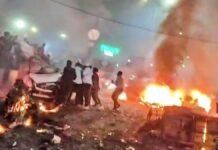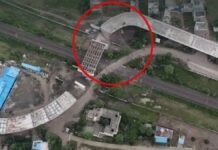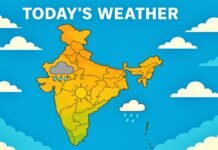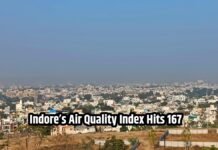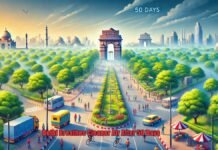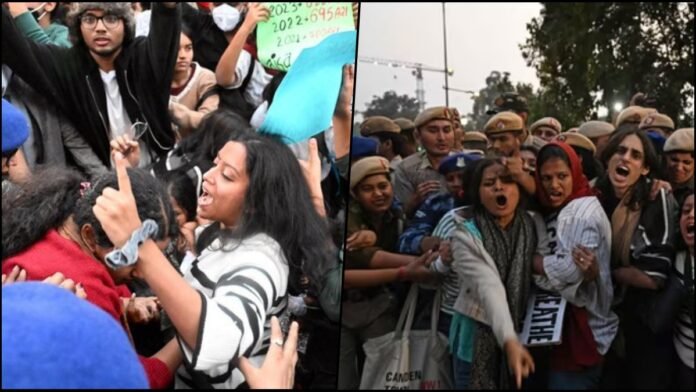
Key Points
- Delhi’s AQI plunged to severe category with multiple areas recording 400+ levels on November 9
- Bawana recorded highest AQI of 436, followed by Patparganj (425) and RK Puram (422)
- Hundreds of citizens including parents, environmentalists protest at India Gate demanding concrete action
- AAP leader Priyanka Kakkar accuses BJP government of data manipulation and denial
- Police detain several protesters citing Supreme Court order limiting demonstrations to Jantar Mantar
- Protesters demand long-term policy solutions beyond temporary measures like water sprinkling
New Delhi: The national capital woke up to another toxic morning on Sunday, November 9, with air quality plummeting to alarming levels across the city. Data from the Air Quality Early Warning System showed an overall AQI of 392 in the early morning hours, while multiple monitoring stations recorded readings well above the 400-mark, firmly placing Delhi in the ‘severe’ category.
According to the Central Pollution Control Board’s (CPCB) real-time monitoring through the SAMEER app, Bawana recorded the city’s highest AQI at 436, making it one of the most polluted locations in India. Patparganj logged 425, RK Puram registered 422, Alipur showed 415, Anand Vihar recorded 412, and Chandni Chowk measured 409, all classified as ‘severe’ and posing serious health risks.
Just a day earlier, on Saturday, Delhi’s overall AQI stood at 355 in the morning, categorized as ‘very poor.’ The sharp deterioration within 24 hours underscores the rapid intensification of the pollution crisis that has gripped the capital since Diwali festivities.
Citizens Take tothe Streets in Desperate Plea
Frustrated by government inaction and increasingly hazardous air conditions, hundreds of Delhi residents gathered at India Gate on Sunday evening to stage a spontaneous protest demanding urgent policy interventions to address the air pollution emergency. The demonstration represented a cross-section of society, including concerned parents accompanied by young children, environmental activists, healthcare advocates, and ordinary citizens fed up with breathing toxic air.
Many protesters were mothers who brought their children along to highlight the severe health impact on the younger generation. Prominent environmentalist Bhavreen Khandari, speaking to the media at the protest site, articulated the desperation driving parents to take action: “We want to meet our elected officials. We had sought an appointment with the chief minister but were refused. So many parents are here because their children are suffering. Every third child already has damaged lungs; they will live nearly 10 years less than those growing up in cleaner air.”
The protesters emphasized that their demonstration was peaceful and aimed solely at drawing attention to what they characterized as complete government inaction despite the escalating health crisis affecting millions of residents.
Political Leaders Join Public Outcry
Aam Aadmi Party leader Priyanka Kakkar joined the protesters at India Gate, launching a sharp attack on the BJP-led government for what she termed deliberate denial and data manipulation regarding pollution levels. Speaking to reporters at the protest venue, Kakkar accused authorities of hiding behind fabricated statistics while ordinary citizens suffered.
“People of Delhi are angry because the government of the national capital is in denial. They are not accepting that there is pollution. Rekha Gupta is sitting in her office-home after ordering 13 air purifiers. She should have been here. This is public anger. Because the BJP government didn’t take even a single step to address pollution and everyone knows it this time,” Kakkar stated, highlighting the growing disconnect between government officials protected by personal air purifiers and the general population forced to breathe toxic air.
Leaders from the Congress party also participated in the demonstration, joining citizens in demanding transparency, accountability, and effective policy measures to combat the annual pollution crisis that has become Delhi’s recurring nightmare.
Police Intervention and Detentions
As protesters assembled near India Gate, Delhi Police swiftly intervened, informing demonstrators that the iconic monument is not an authorized location for protests as per Supreme Court directives. Police officials clarified that under current regulations, protests in the national capital are only permitted at Jantar Mantar, which has been designated as the official protest site.
Several protesters were detained for violating these restrictions and for assembling without prior permission. A police officer explained the action: “The detentions were necessary to maintain law and order and ensure there is no obstruction in security arrangements.” The remaining protesters were directed to proceed to Jantar Mantar if they wished to continue their demonstration.
The police action drew criticism from protesters who argued that the severity of the health emergency justified their right to peaceful assembly and that bureaucratic restrictions should not supersede citizens’ fundamental right to demand breathable air.
Demand for Real Solutions, Not Band-Aid Measures
The protesters voiced strong frustration with what they characterized as purely cosmetic and temporary measures implemented by authorities without addressing the root causes of Delhi’s pollution crisis. One protester articulated the widespread sentiment: “People are getting sick and dying from pollution, but the government is only resorting to ineffective measures like water sprinkling and cloud seeding.”
Demonstrators demanded that the government reveal authentic, unmanipulated pollution data to the public and formulate comprehensive long-term policies instead of reactive, short-duration interventions that have proven ineffective year after year. They called for accountability mechanisms, scientific monitoring, and transparent communication about health risks.
The protesters highlighted that every year during October-November, Delhi experiences the same pollution spike, yet authorities respond with identical temporary measures, construction bans, water sprinkling on roads, and odd-even vehicle schemes without implementing permanent structural solutions to eliminate pollution sources.
Root Causes Remain Unaddressed
Environmental experts and protesters alike identified four primary contributors to Delhi’s annual pollution emergency: stubble burning in neighboring Punjab and Haryana states, vehicular emissions from Delhi’s massive automobile fleet, industrial smoke from NCR manufacturing units, and construction dust from ongoing infrastructure projects.
According to scientific assessments, stubble burning contributes approximately 20-40% of Delhi’s pollution during October-November when farmers clear harvested rice fields by burning crop residue. Despite repeated government announcements about providing alternative machinery and imposing penalties, the practice continues largely unabated due to a lack of economically viable alternatives and weak enforcement.
Vehicular emissions account for roughly 30% of Delhi’s pollution year-round, exacerbated by the city’s 12 million registered vehicles. While Stage 2 of the Graded Response Action Plan (GRAP) has been invoked, including doubling parking fees to discourage vehicle use, critics argue these measures provide minimal impact without aggressive promotion of public transport and electric vehicle adoption.
Industrial emissions and construction dust contribute to the remaining pollution load. While GRAP Stage 2 mandates construction restrictions, enforcement remains patchy, and industries continue operating with inadequate pollution control equipment.
Health Crisis Deepens
Medical experts warn that prolonged exposure to AQI levels above 400 causes severe health consequences, particularly for children, elderly citizens, and those with pre-existing respiratory or cardiovascular conditions. Short-term effects include breathing difficulties, eye irritation, throat inflammation, and exacerbation of asthma.
Long-term exposure leads to permanent lung damage, reduced lung capacity, increased cancer risk, cardiovascular disease, and neurological impacts. Studies have shown that children growing up in Delhi suffer measurable lung damage equivalent to smoking multiple cigarettes daily, with life expectancy reduced by nearly a decade compared to those raised in cleaner environments.
Hospitals across Delhi have reported significant increases in respiratory emergency admissions, with pediatric wards seeing particularly alarming spikes in bronchitis, asthma attacks, and pneumonia cases.
Growing Public Frustration Signals Tipping Point
The spontaneous India Gate protest represents a potentially significant shift in public response to Delhi’s annual pollution crisis. Historically, residents have endured the toxic air with resignation, implementing personal protective measures like air purifiers and masks while waiting for seasonal wind patterns to disperse pollutants.
However, the participation of ordinary citizens, not just organized activist groups, along with mothers bringing children to demand action, suggests growing awareness that individual coping mechanisms cannot substitute for systemic government intervention. Protesters emphasized that they are prepared to escalate demonstrations if authorities continue avoiding substantive policy reforms.
The convergence of health emergencies, political accountability demands, and citizen mobilization indicates that Delhi’s pollution crisis may be entering a new phase where public tolerance for governmental inaction reaches its limit, forcing authorities to move beyond temporary palliatives toward permanent structural solutions.





